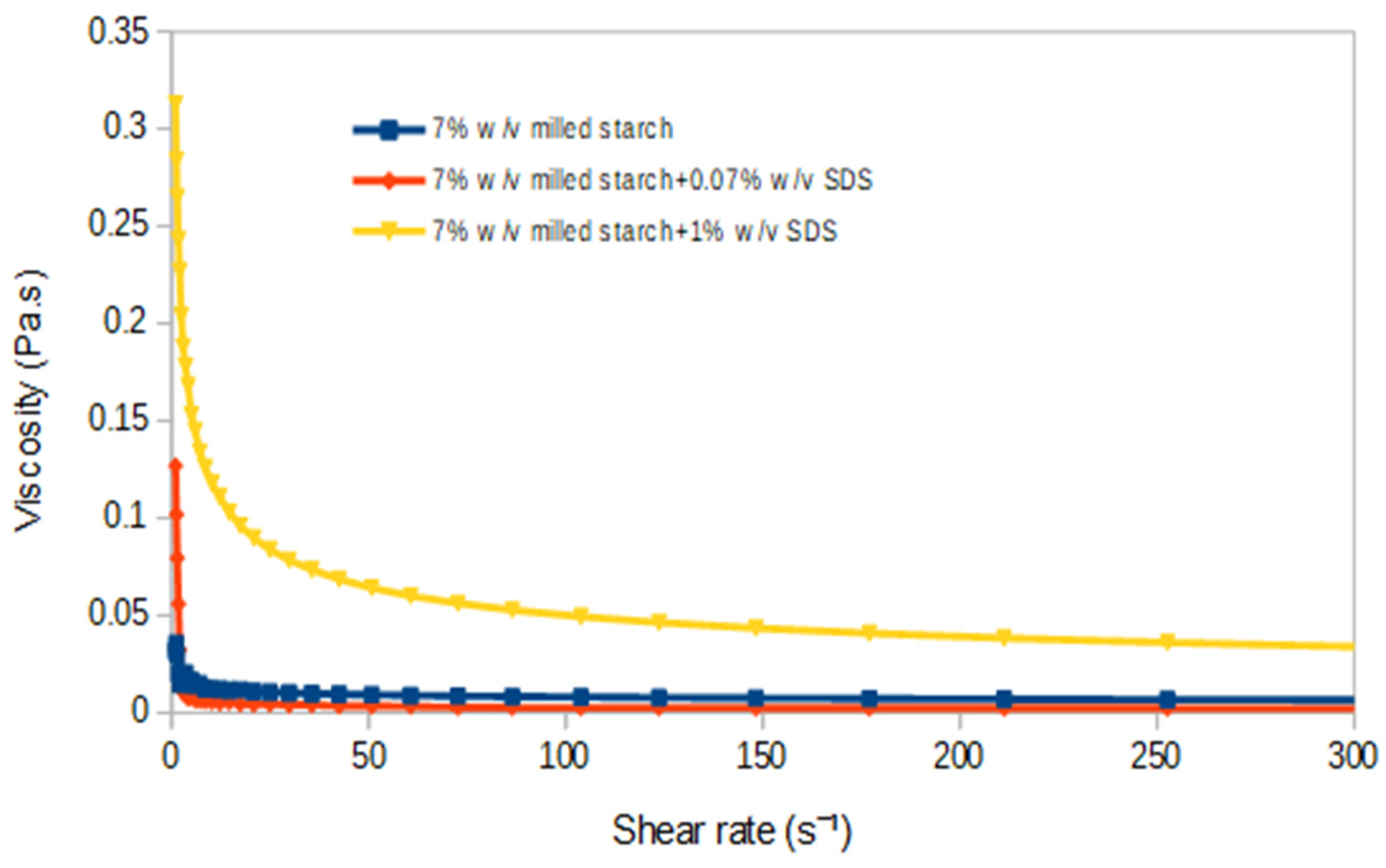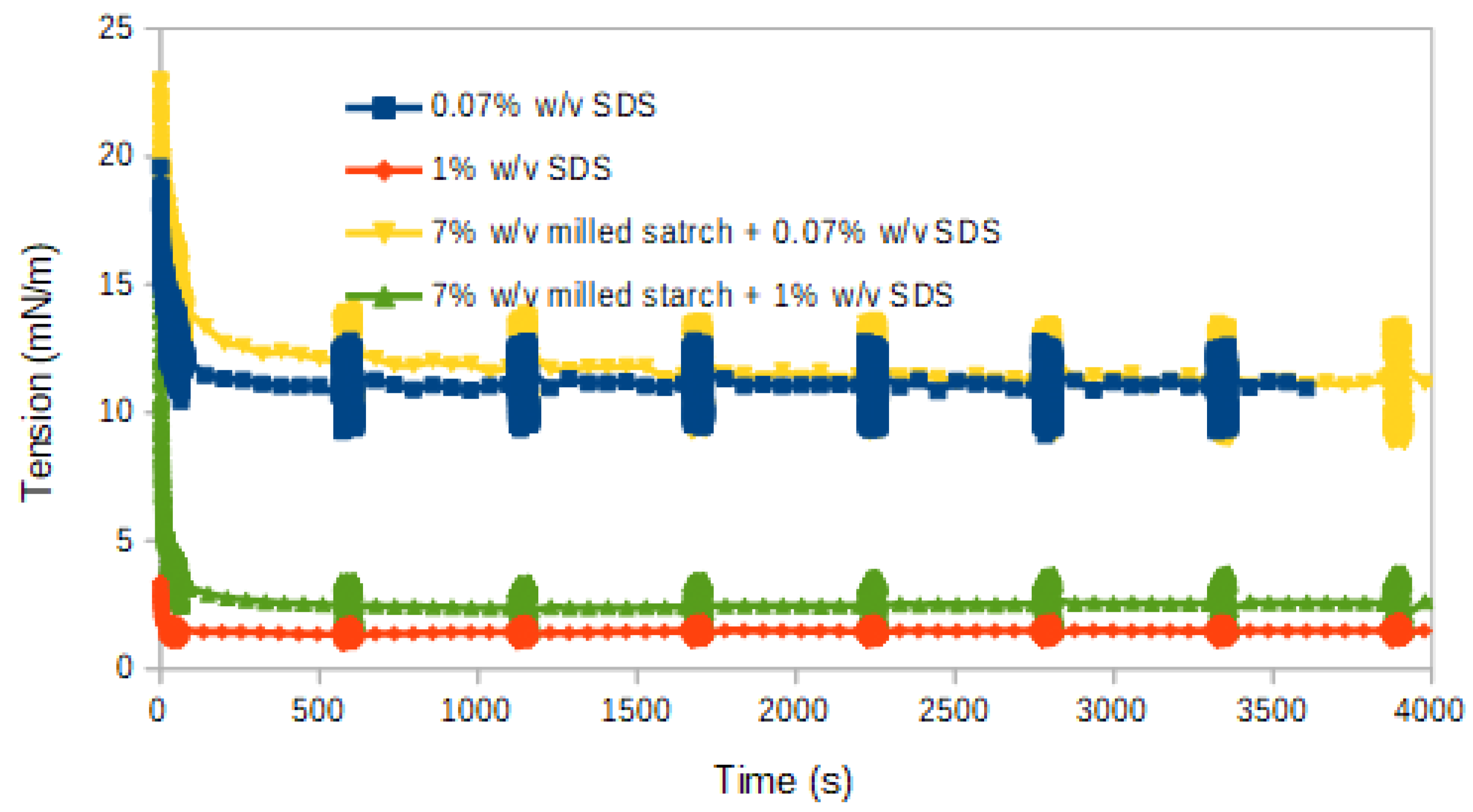Formulation of Sustainable Biopolymer-Based Nanoparticles Obtained via Media Milling for Chia Oil Vehiculization in Pickering Emulsions †
Abstract
:1. Introduction
2. Materials and Methods
2.1. Materials
2.2. Milling Experimental Design
2.3. Characterization of Corn Starch Nanosuspensions
2.4. Preparation and Characterization of Pickering Emulsions Stabilized with Corn Starch Nanoparticles
2.5. Spray Drying and Characterization of Powders
3. Results and Discussion
3.1. Characterization of Nanosuspensions and Pickering Emulsions
3.2. Characterization of Powders
4. Conclusions
Author Contributions
Funding
Institutional Review Board Statement
Informed Consent Statement
Data Availability Statement
Acknowledgments
Conflicts of Interest
References
- Marcillo-Parra, V.; Tupuna-Yerovi, D.S.; González, S.; Ruales, J. Encapsulation of bioactive compounds from fruit and vegetable by-products for food application—A review. Trends Food Sci. Technol. 2021, 116, 11–23. [Google Scholar] [CrossRef]
- Zhu, F. Starch based Pickering emulsions: Fabrication, properties, and applications. Trends Food Sci. Technol. 2019, 85, 129–137. [Google Scholar] [CrossRef]
- Gonzalez-Ortiz, D.; Pochat-Bohatier, C.; Cambedouzou, J.; Bechelany, M.; Miele, P. Current trends in Pickering emulsions: Particle morphology and applications. Engineering 2020, 6, 468–482. [Google Scholar] [CrossRef]
- Breitung-Faes, S.; Kwade, A. Mill, material, and process parameters-A mechanistic model for the set-up of wet-stirred media milling processes. Adv. Powder Technol. 2019, 30, 1425–1433. [Google Scholar] [CrossRef]
- Bordón, M.G.; Martínez, M.L.; Chiarini, F.; Bruschini, R.; Camacho, N.; Severini, H.; Palma, S.D.; Ribotta, P.D. Preparation of corn starch nanoparticles by wet-stirred media milling for chia oil vehiculization. Biol. Life Sci. Forum. 2022, 17, 1. [Google Scholar] [CrossRef]
- Martínez, M.L.; Marín, M.A.; Faller, C.M.S.; Revol, J.; Penci, M.C.; Ribotta, P.D. Chia (Salvia hispanica L.) oil extraction: Study of processing parameters. LWT Food Sci. Technol. 2012, 47, 78–82. [Google Scholar] [CrossRef]
- Bordón, M.G.; Paredes, A.J.; Camacho, N.M.; Penci, M.C.; González, A.; Palma, S.D.; Ribotta, P.D.; Martínez, M.L. Formulation, spray-drying and physicochemical characterization of functional powders loaded with chia seed oil and prepared by complex coacervation. Powder Technol. 2021, 391, 479–493. [Google Scholar] [CrossRef]
- Fu, Z.-Q.; Wang, L.-J.; Li, D.; Adhikari, B. Effects of partial gelatinization on structure and thermal properties of corn starch after spray drying. Carbohydr. Polym. 2012, 88, 1319–1325. [Google Scholar] [CrossRef]
- Bordón, M.G.; Alasino, N.P.X.; Vilanueva-Lazo, A.; Carrera-Sánchez, C.; Pedroche-Jiménez, J.; Millán-Linares, M.C.; Ribotta, P.D.; Martínez, M.L. Scale-up and optimization of the spray drying conditions for the development of functional microparticles based on chia oil. Food Bioprod. Process. 2021, 130, 48–67. [Google Scholar] [CrossRef]
- Felix, M.; Romero, A.; Carrera-Sánchez, C.; Guerrero, A. Assessment of interfacial viscoelastic properties of Faba bean (Vicia faba) protein-adsorbed O/W layers as a function of pH. Food Hydrocoll. 2019, 90, 353–359. [Google Scholar] [CrossRef]
- Hay, W.; Fanta, G.; Felker, F.; Peterson, S.; Skory, C.; Hojilla-Evangelista, M.; Biresaw, G.; Selling, G. Emulsification properties of amylose-fatty sodium salt inclusion complexes. Food Hydrocoll. 2019, 90, 490–499. [Google Scholar] [CrossRef]





| Nanosuspension | K | n | ζ | Zi | Zf | PDIi | PDIf |
|---|---|---|---|---|---|---|---|
| 7% w/v milled starch | 0.019 a | 0.81 a | −9.06 a | 457.8 a | 1356.5 a | 0.34 a | 0.65 a |
| 7% w/v milled starch + 0.07% w/v SDS | 0.008 a | 0.77 a | −17.20 b | 204.0 b | 582.0 b | 0.26 b | 0.58 a |
| 7% w/v milled starch + 1% w/v SDS | 0.269 b | 0.63 b | −27.35 c | 344.6 c | 457.8 c | 0.43 c | 0.34 b |
| Nanosuspension | Zi | Zf | PDIi | PDIf |
|---|---|---|---|---|
| 7% w/v milled starch | 2288.5 a | 8058.5 a | 1.00 a | 1.00 a |
| 7% w/v milled starch + 0.07% w/v SDS | 373.9 b | 8594.5 a | 0.65 b | 1.00 a |
| 7% w/v milled starch + 1% w/v SDS | 272.1 c | 327.1 b | 0.41 c | 0.47 b |
Disclaimer/Publisher’s Note: The statements, opinions and data contained in all publications are solely those of the individual author(s) and contributor(s) and not of MDPI and/or the editor(s). MDPI and/or the editor(s) disclaim responsibility for any injury to people or property resulting from any ideas, methods, instructions or products referred to in the content. |
© 2023 by the authors. Licensee MDPI, Basel, Switzerland. This article is an open access article distributed under the terms and conditions of the Creative Commons Attribution (CC BY) license (https://creativecommons.org/licenses/by/4.0/).
Share and Cite
Bordón, M.G.; López-Vidal, L.; Camacho, N.; Martínez, M.L.; Penci, M.C.; Carrera-Sánchez, C.; Pizones Ruiz Henestrosa, V.; Palma, S.D.; Ribotta, P.D. Formulation of Sustainable Biopolymer-Based Nanoparticles Obtained via Media Milling for Chia Oil Vehiculization in Pickering Emulsions. Biol. Life Sci. Forum 2023, 25, 20. https://doi.org/10.3390/blsf2023025020
Bordón MG, López-Vidal L, Camacho N, Martínez ML, Penci MC, Carrera-Sánchez C, Pizones Ruiz Henestrosa V, Palma SD, Ribotta PD. Formulation of Sustainable Biopolymer-Based Nanoparticles Obtained via Media Milling for Chia Oil Vehiculization in Pickering Emulsions. Biology and Life Sciences Forum. 2023; 25(1):20. https://doi.org/10.3390/blsf2023025020
Chicago/Turabian StyleBordón, María G., Lucía López-Vidal, Nahuel Camacho, Marcela L. Martínez, María C. Penci, Cecilio Carrera-Sánchez, Víctor Pizones Ruiz Henestrosa, Santiago D. Palma, and Pablo D. Ribotta. 2023. "Formulation of Sustainable Biopolymer-Based Nanoparticles Obtained via Media Milling for Chia Oil Vehiculization in Pickering Emulsions" Biology and Life Sciences Forum 25, no. 1: 20. https://doi.org/10.3390/blsf2023025020
APA StyleBordón, M. G., López-Vidal, L., Camacho, N., Martínez, M. L., Penci, M. C., Carrera-Sánchez, C., Pizones Ruiz Henestrosa, V., Palma, S. D., & Ribotta, P. D. (2023). Formulation of Sustainable Biopolymer-Based Nanoparticles Obtained via Media Milling for Chia Oil Vehiculization in Pickering Emulsions. Biology and Life Sciences Forum, 25(1), 20. https://doi.org/10.3390/blsf2023025020









